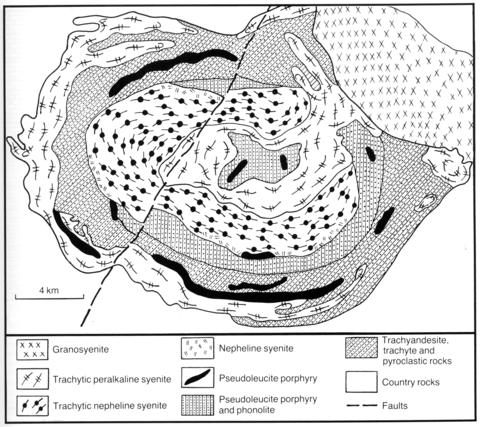stripes
The Tezhsar alkaline complex has an area of about 80 km2, is of central type and is developed in an elevated part of the Prisevanskaya zone of the Pambaksky range. A distinguishing feature of the complex is its ring-shaped structure and the combination of effusive and intrusive facies which it contains. The alkaline effusive series is 600 m thick and occurs as a broad, ring-shaped zone 12 to 15 km2 in area towards the outer part of the complex. This series consists of three almost equally thick, pyroclastic formations which, from bottom to top, consist of (1) trachyandesites, (2) trachytes and (3) leucite phonolites or pseudoleucite porphyries. Also found in this series are alkaline potassium-rich basalts, leucite tephrites, shoshonites, sanidine and leucite trachytes, phonolites, leucitophyres and italites consisting almost solely of leucite. There are dykes of bostonite, essexite porphyry and alkaline lamprophyres, as well as an arc of dykes 1-5 m thick of pseudoleucite phonolite and syenite porphyry. There is replacement of the extrusive rocks by albite, muscovite and fluorite. The intrusive rocks of Tezhsar comprise (1) the alkaline syenites of the outer ring, (2) pseudoleucite syenites, (3) nepheline syenites, (4) nordmarkites and (5) peralkaline syenites and quartz syenites. These rocks define concentric zones the pseudoleucite syenites (15 km2) and peralkaline syenites (16 km2) in particular forming well defined arcs. To the marginal parts of the core are confined zones of nepheline-rich pseudoleucite syenites, which approach foyaite in composition. The pseudoleucite syenites consist of idiomorphic, more frequently ovoidal, pseudoleucites (30 to 40%) 2 to 6 cm in diameter set in a matrix of granular nepheline and alkali feldspar. The pseudoleucite represents pseudomorphs having the typical intergrown texture of sodium-rich nepheline (25 to 35%) and sodium-depleted orthoclase (Or90Ab10). The central, conical intrusion is composed of peralkaline syenites, which grade in some places to peralkaline monzonites, nordmarkites and pulaskites. There are dykes of peralkaline and nepheline microsyenites, nepheline syenite porphyries, aplite, aplites dominantly composed of albite, tinguaite and bostonite, as well as feldspar and feldspathoid pegmatites.
ABOVYAN, S.B., AGAMALYAN, V.A. and ASLANYAN, A.T. et al. 1981. I.G. Magakyan (ed) Magmatic and metamorphic formations of the Armenian SSR. Akademii Nauk Armyanskoi SSR, Erevan. 331 pp.
BAGDASARYAN, G.P. 1956. Petrography of alkaline effusive rocks. Ivestiya Akademii Nauk Armyanskoi SSR, Seriya Geologiya. Erevan, 2: 25-36.
BAGDASARYAN, G.P. 1966. Intrusive rocks of the Basumo-Pambaksky region. In Geology of the Armenian SSR. Petrography. Intrusive rocks. 3: 256-308. Armenian Academy of Sciences, Erevan.
DZHSRBASHYAN, R.T. and MELIKSETYAN, B.M. 1974. Geochemical and petrogenetic peculiarities of the alkaline volcanic series of the Pambaksky ridge. In Magmatism and metallogenesis of the Armenian. SR. 54-67. Akademii Nauk Armyanskoi SSR, Erevan.
KOCHINYAN, R.E. 1975. Mineralogy and geochemistry of the alkaline rocks of the Pamback. Akademii Nauk Armyanskoi SSR, Erevan. 175 pp.
KOTLYAR, V.N. 1939. Discovery of the leucitic rocks in the Caucasus. Sovetskaya Geologiya, 4-5: 4-11.
MELIKSETYAN, B.M. 1971. Mineralogy, geochemistry and petrological peculiarities of the Tezhsarskii complex. In Petrology of the intrusive complexes of the important regions of the Armenian SSR. 117-308. Akademii Nauk Armyanskoi SSR, Erevan.

